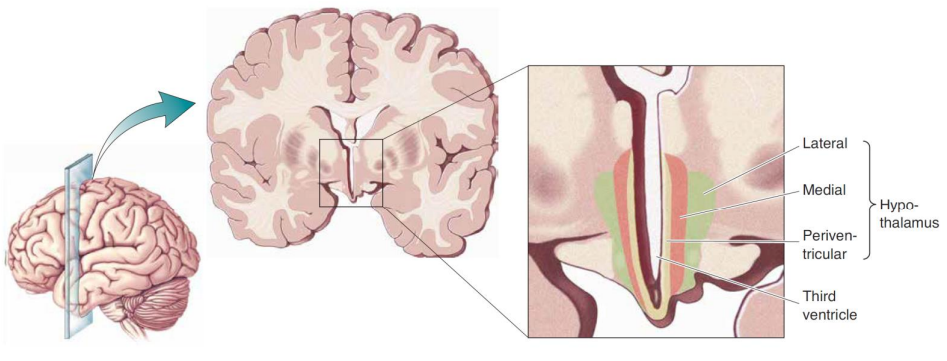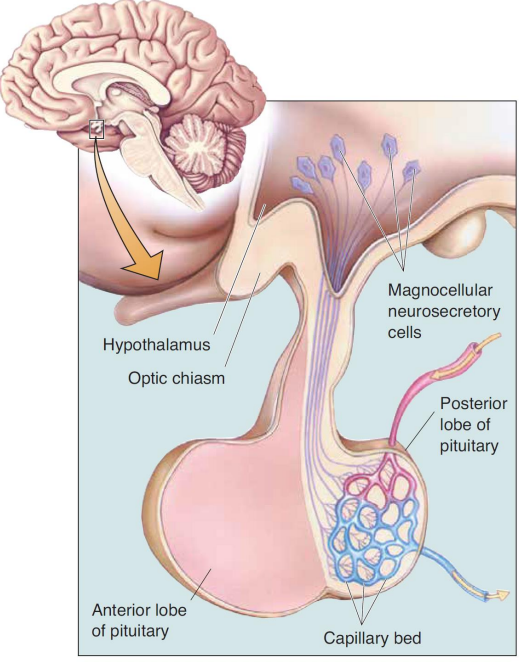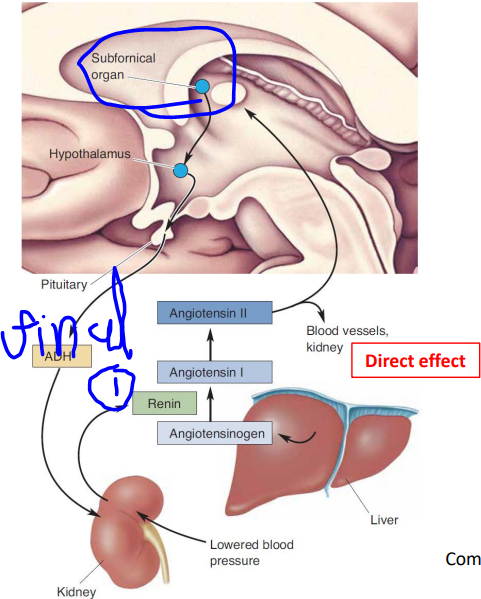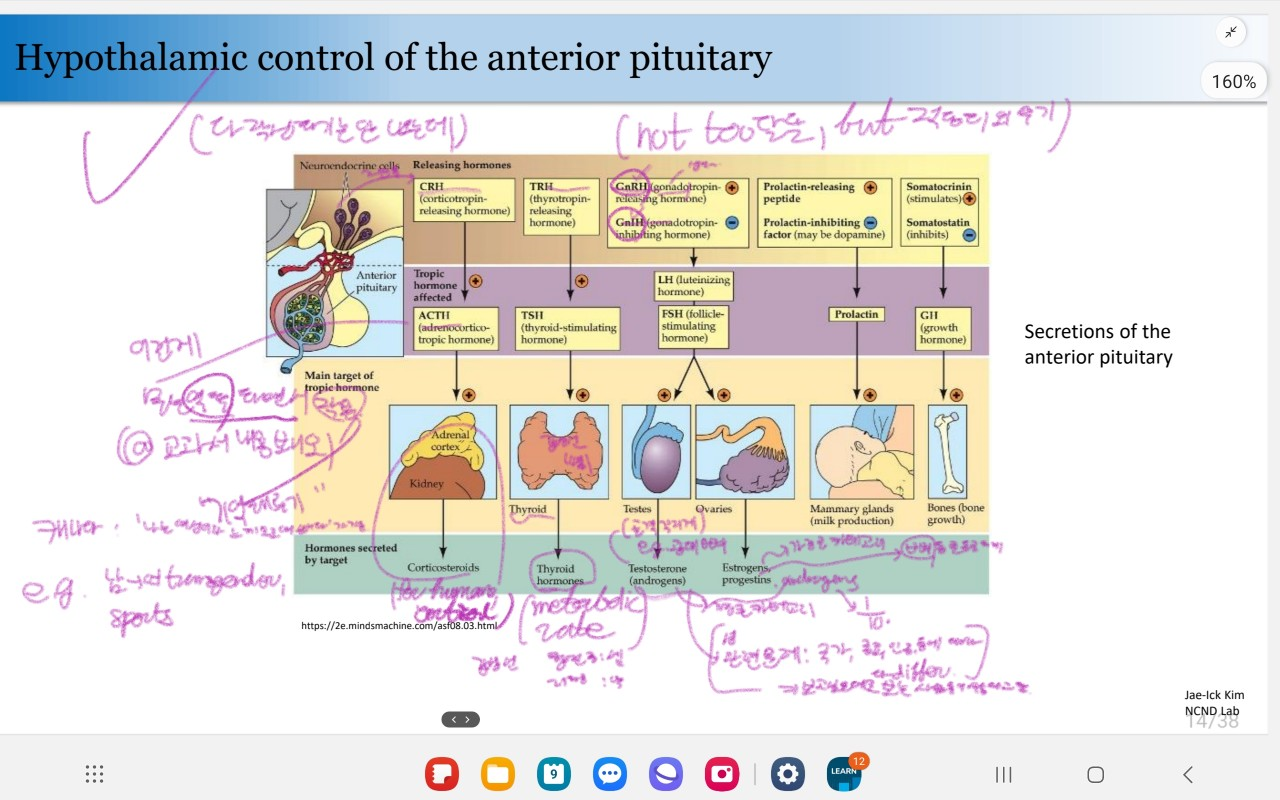[NS14] Chemical Control of the Brain and Behavior
Introduction
Communication in the nervous system
- point-to-point communication
- Influence of one neuron is targeted to a small number of other neurons.
- Tightly constrained in both space and time (a few msec)
- e.g. sensory or motor systems.
- Communication with many cells
- Slowly (seconds~minutes)
1. The Secretory Hypothalamus
1.1. An Overview of the Hypothalamus
hypothalamus:
- Location: Below the thalamus, along the walls of the third ventricle (forebrain)
- Integrates somatic and visceral responses if needed.
- Regulates internal condition of the body in response to a changing external environment: homeostasis.
1.1.1. Homeostasis
- Homeostasis: The maintenance of the body’s internal environment within a narrow physiological range.
- example:
- Temperature regulation
- Low
- Blood vessles constrict => heat is conserved.
- Sweat glands do not secrete fluid.
- Turn blue: shunt blood away from surface tissues => keep sensitive core of the body warmer.
- Shiver (involuntary contraction of muscles => generate heat in the muscles)
- Goose bumps (a futile attempt to fluff up your nonexistent fur for better insulation. a reflexive remnant from harrier ancestors)
- High
- Blood vessles dilate => heat loss to env.
- Sweat glands secrete fluid. (evaporate => heat is lost from the body)
- Turn red: shunt blood to surface tissues where heat can radiate away.
- Low
- Temperature regulation
1.1.2. Structure and Connections of the Hypothalamus
3 zones:
-
- lateral, medial
- Extensive connections with…
- the brain stem
- the telencephalon
regulate certain types of behavior.

- periventricular
- Location: Right next to the wall of the third ventricle.
- Complex mix of neurons. e.g.
- Supra Chiasmatic Nucleus (SCN)
- Location: just above the optic chiasm.
- Input: direct retinal innervation
- Fn: Sync. circadian rhythms with daily light-dark cycle.
- neurosecretory neurons
- Control ANS
- regulate pituitary gland.
- Supra Chiasmatic Nucleus (SCN)
1.2. Pathways to the pituitary (Posterior and Anterior)
1.2.1. Hypothalamic Control of the Posterior Potuitary
- Neurohormones: Substances released into the blood by neurons.
- the subfornical organ: a part of the telencephalong that lacks a BBB.
magnocellular neurosecretory cells
- extend axons down the stalk of the pituitary and into the posterior lobe.

release 2 kinds of neurohormones directly into the capillaries of the posterior lobe.
They have the following properties:
- peptides
- a chain of 9 aa.s
- Oxytocin
- rise when…
- sexual/intimate behaviors
- somatic sensations generated by a suckling baby
- cortex informed by somatic, visual, or auditory pathways stimulates the hypothalamus to release oxytocin.
- Function
- Promote social bonding
- Cause the uterus to contract => facilitate the delivery
- Stimulates ejection of milk from the mammary glands
- rise when…
- Vasopressin (antidiuretic hormone, ADH)
- Trigger: (low blood volume <=> P, high blood salt concentration)
- Pressure receptors in the cardiovascular system (P is low => hypothalamus)
- Salt concentration-sensitive cells in the hypothalamus (C is high)
- Fn (Regulates blood volume and salt concentration)
- water retention
- reduced urine production
- Process
- low blood P in kidney
- kidney release renin
- renin converts Angiotensin from liver to angiotensin I => angiotensin II.
- Angiotensin II…
- Direct effect on kidneys & blood vessels
- Detected by the subfornical organ =>
- Activate ADH-containing neurosecretory cells in the hypothalamus (control of visceral organs)
- Activate cells in the lateral hypothalamus => Promote thirst (control of behavorial responses)
- Trigger: (low blood volume <=> P, high blood salt concentration)

1.2.2. Hypothalamic Control of the Anterior Pituitary
Terms:
-
- hypophysiotropic hormone
- A peptide hormone releasd into the blood by the parvocellular neurosecretory cells of the hypothalamus; stimulates/inhibits the secretion of hormones from the anterior pituitary
-
- hypothalamo-pituitary portal circulation
- A system/network of blood vessels that carries hypophysiotropic hormones from the hypothalamus to the anterior pituitary.
- adrenal cortex
- adrenal medulla
Anterior Pituatary
- body’s “master gland” (traditionally)
- NOT a part of the brain(CNS)
- Controlled by parvocellular neurosecretory cells of the periventricular hypothalamus by releasing the hypophysiotropic hormones. (“true master gland”)
Example
- adrenal cortex produce cortisol (steroid)
- fn:
- mobilize(=use) energy reserves of body
- suppress immune system => cope with life’s various stress.
- good stimulus for release: stress
- physiological strss e.g. loss of blood
- positive emotional stimulation. e.g. falling in love
- phychological stress; anxity over an upcoming exam.
- stress is determined by the parvocellular neurosecrtory cells (by the release of cortisol) that control the adrenal cortex
Process
- parvocellular neurosecrtory cells release Corticotropin-Releasing Hormone (CRH) into the blood of the portal circulation.
- CRH travels to the anterior pituitary. stimulates the release of corticotropin(=adrenocorticotropic hormone (ACTH)) into the general circulation.
- ACTH travels to the adrenal cortex, stimulating cortisol release.
| Hormone | Target | Action |
|---|---|---|
| FSH; Follicle-Stimulating Hormone | Gonads | Ovulation, spermatogenesis |
| LH; Lutenizing Hormone | Gonads | Ovarian and sperm maturation |
| TSH; Thyroid-Stimulating Hormone (=thyrotropin) | Thyroid | Thyroxin secretion ( => inc metabolic rate) |
| ACTH(adreno cortico tropic hormone) (=corticotropin) | Adrenal cortex | Cortisol secretion (mobilize E stores, inhibits immune system, etc.) |
| GH; growth hormone | All Cells | Stimulation of protein synthesis |
| Prolactin | Mammary glands | Growth and milk secretion |
(portal circulation <-> general circulation)

Regulation of the adrenal glands

.png)